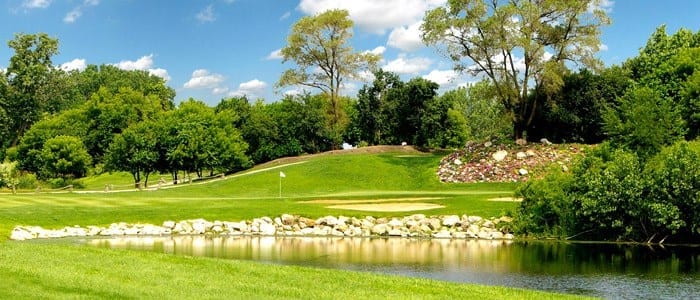
Chicago Golf Report has noticed a trend at famous golf courses where a succession of three challenging holes is given a nickname. Augusta National Golf Club, site of the Masters, has its ‘Amen Corner’ at holes #11 (White Dogwood), #12 (Golden Bell), and #13 (Azalea). PGA National, designed by Jack Nicklaus, has ‘The Bear Trap’ when golfers reach holes #15-16-17. And in Palm Harbor FL, near Tampa, the Copperhead course at Innisbrook Golf Resort finishes their eighteen hole routing with its ‘Snake Pit’ on #16 (Moccasin), #17 (Rattler), and #18 (Copperhead).
So, what about nicknames for Chicago area courses that present triple threat challenges for its patrons? Trying to recall local public access courses with three difficult holes in a row Chicago Golf Report has produced this short list of terrific trifectas, and has created apropos nicknames for them, sometimes colorful and sometimes even humorous.
Veterans Memorial Golf Course (Holes 6-7-8) “The Navy’s Nor’easter”
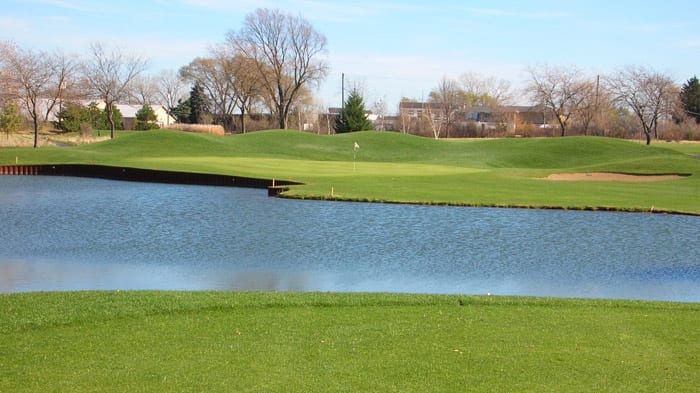
Veterans Memorial Golf Course – 7th Hole
Any course that can pack three very testy holes into the northeast corner of their property is creating the conditions for the ‘perfect storm’, a nor’easter, to challenge its golfing patrons. And so it is at Veterans Memorial Golf Course, formerly known as Willow Glen Golf Club, the course at the Great Lakes Naval Training Center. While it is located on the grounds of a military base, Veterans Memorial Golf Course is open to the public.
This tough trio of holes begins at the #6 tee, a par-4 tipping at 452 yards; it is the number one handicap hole. A sculpted fairway contains two fairway bunkers, a leftside fairway bunker at 220-240 yards from the back tee, and a rightside fairway bunker at 110-90 yards from the green. A front-right greenside bunker adds one more sand hazard to dissuade sub-par scores here. Out-of-bounds borders the entire leftside, tee to green.
A forced carry over a pond is the challenge on the par-3 seventh hole which plays at 144 yards from the blue tee. A small ridge across the latitude of the green creates a two-tiered effect. Pushed tee shots can catch the greenside bunker to the right, while pulled tee shots fly towards the fatter, longer-carry, portion of the pond.
Hole number eight is a tricky, potential score-wrecker. It is a par-5, 497 yards from the blue tees, but will generally play into a summer south wind or have a westerly cross wind blowing shots towards the out-of-bounds fence bordering the left side. There is a fairway bunker 100 yards from the green on the left, and a right front greenside bunker as golfers approach the green. The green is wide but shallow. Pulled tee shots that stay on course property but not out of bounds will likely need to play sideways to the fairway. There are a limited number of trees along the sides of the fairway, but are always positioned in critical locations.
Foss Park (Holes 13-14-15) “Acorn Alley”
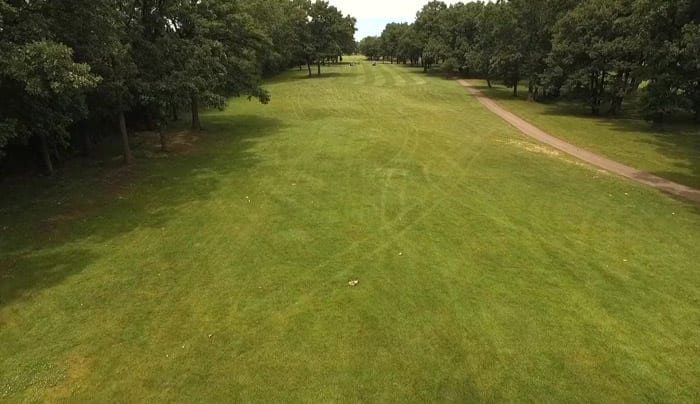
Foss Park Golf Course – 13th Hole
‘Alley’ as defined in the Merriam-Webster dictionary is ‘a garden or park walk bordered by trees or bushes’. Further, the Oxford-English dictionary’s definition 1.1 for the same word is ‘a path lined with trees, bushes, or stones’. There is a trio of forested holes at Foss Park Golf Course that feature hundreds of hardwood trees, especially mature oaks. These stately acorn producers line the entire fairways of holes number thirteen and fourteen and form an alcove around the fifteenth tee. This sequence of a par-5, a par-4, and a par-3 now receives the nickname of “Acorn Alley.”
Hole number thirteen is an extremely tight par-5 measuring 507 yards from the back tees. Trees completely line both sides of the fairway, with a few trees pinching from both sides towards the fairway’s middle at various distances off the tee. If a straight line were drawn from tee to green, it would have only 5 yards to its left and right to avoid tree interference — effectively, a 10 yard wide fairway! Chopping up the par-5 distance into three shots while favoring certain sides of the fairway is recommended to avoid caroms off of the trees. A tough task for golfers with sidespin.
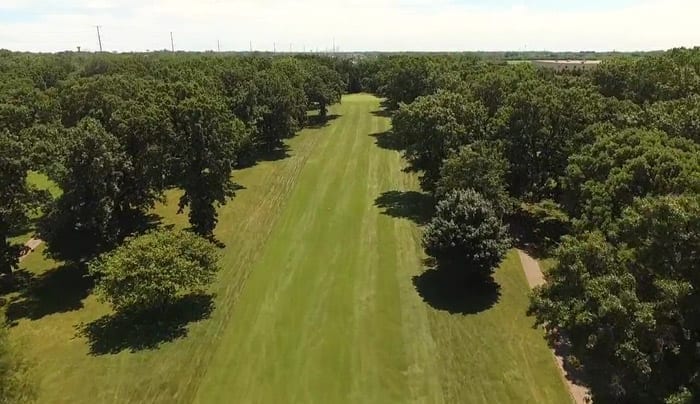
Foss Park Golf Course – 14th Hole
Next up is a long par-4 (back tee: 436 yards), once again, with a fairway entirely surrounded by mature hardwoods trees. A long tee shot plus a long fairway shot are required to conquer this par-4’s lengthy distance, and for many golfers an additional third shot might also be needed. Fortunately, there are no bunkers whatsoever on this hole. ‘Can you see the forest through the trees’, might be followed by ‘can you see the fairway through the trees’.
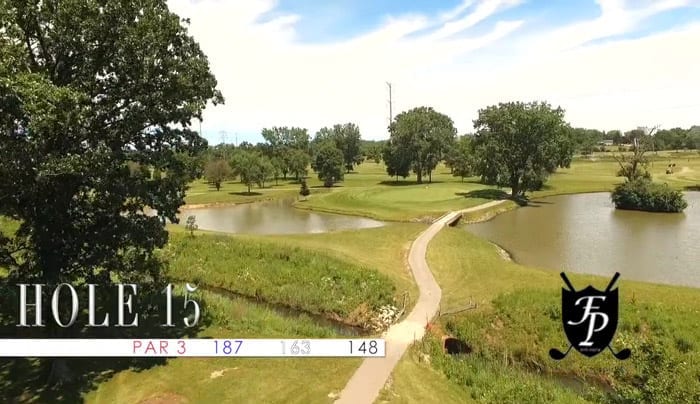
Foss Park Golf Course – 15th Hole
The par-3 fifteenth hole’s tee shot is hit from an alcove of trees and over a pond to a green 187 yards away. Around the tee, the trees offer blockage from the wind, but as the tee shot passes the last of the bordering trees and begins traveling over the pond, the wind’s effect is more pronounced. Depending upon the wind’s direction and velocity, a shaped tee shot or a low trajectory tee shot may be required.
Crane’s Landing at Marriott Lincolnshire (Holes 16-17-18) “The Crane’s Beak”
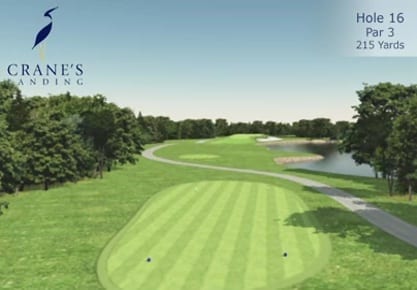
Crane’s Landing Golf Club – 16th Hole
One of the prominent features of the waterfowl crane is its beak. Its characteristics of being long, thin, and sharp make it ideal for spearing fish, but when needed can also be a dangerous defensive weapon, used for its own protection. The same traits (long, thin, and dangerous) can similarly be said about the final three holes at Crane’s Landing Golf Course at the Marriott Lincolnshire Resort, thus earning the nickname “The Crane’s Beak”.
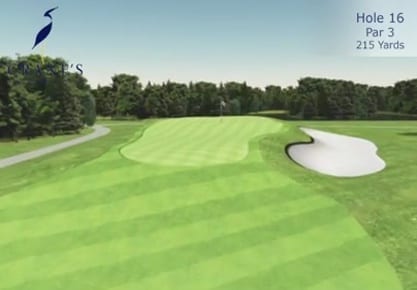
Crane’s Landing Golf Club – 16th Hole
Hole number 16 is a 215-yard (back tees; hdcp 8) par-3. A large pond is situated along the entire right side. The green is very narrow and undulated, with one greenside bunker to its right. Shots hit left of the green will most likely kick and roll across the cart part and into the trees and marshy area which can be designated as a hazard or out-of-bounds.
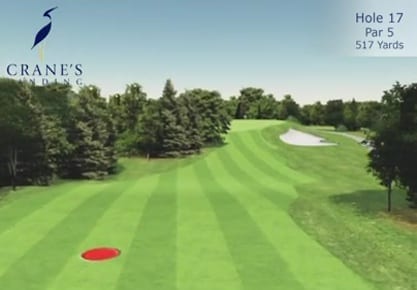
Crane’s Landing Golf Club – 17th Hole
The trees have grown larger at Crane’s Landing, and this is especially noticeable on the 17th hole. Keeping the ball in play three times is crucial on this moderate length par-5 (517 yards back tee; hdcp 9). The more favorable portion of the fairway is the right-center or right edge, especially when getting close to the green. Notice how the drip line from the trees on the left encroaches the left side of the fairway. Just one bunker on seventeen, greenside right.

Crane’s Landing Golf Club – 18th Hole
The eighteenth hole vividly lives up to the adjectives of ‘long, thin, and dangerous’. It is a par-4 with a distance of 447 yards from the back tee (hdcp 2). Once again, notice how large the trees have grown. Two ponds, one left and one right, drown off-line balls as golfers approach the green. The green is somewhat elevated but drops off more severely for shots missing the green on the right. There is a fairway bunker on the right side and a greenside bunker left.
Water’s Edge Golf Course (Holes 11-12-13) “The Water’s Closet”

Water’s Edge Golf Club – 11th Hole
Europeans, when in need of relief, seek the refuge of the water closet, but that is on a different continent on another side of the ocean. We’re now talking about a golf course in Worth, IL. Water’s Edge Golf Course has challenging triad of holes which we’ll now call “The Water’s Closet”, that offers no relief for anything considered less than average golf shots.
Holes 11, 12, and 13 are scenic beauties, starting with the signature hole for the course, the 570 yard (back tees) par-5 eleventh hole. Drives are given a narrow landing area with the canal on the left and a pond to the right. The design of this hole is a ‘fish hook’ which offers a risk / reward opportunity to go directly at the green over water, or play the safer, drier, but longer route around the water. Over the water but just short of the green lurk three bunkers. The massive green features a couple of radical tiers as a final defense against par.
The 12th hole, a par-3, plays from an elevated tee with a number of different tee boxes at various lengths. Furthermore, the green is quite large, so the hole can play at a variety of different lengths. It is recommended to take an extra club on this hole as most often a breeze above the trees will have a tendency to knock shots down. Four bunkers protect the 12th green.
Seemingly benign, but in reality deceptively more difficult than meets the eye, the 418 yard, par-4 eleventh hole concludes the ‘water closet’ trio. Drives should favor the right side of the fairway to avoid tree interference left of the fairway and to provide a better angle to the kidney-clover shaped green. Two bunkers, front and rear, boldly protect the left portion of the 13th green. Relief at “The Water’s Closet” comes only when finishing the three holes at, or below, par.
Prairie Bluff Public Golf Club (Holes 7-8-9) “The Prairie Cellblock”
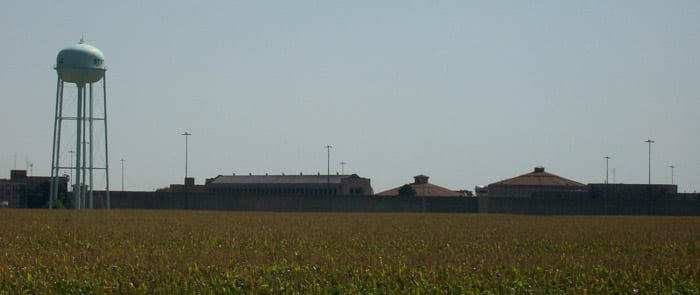
With its proximity to the Stateville Correctional Center, it is naturally fitting that a nickname for Prairie Bluff‘s stretch of three difficult holes have a reference to incarceration. Hence, holes 7-8-9 comprise “The Prairie Cellblock”. With handicaps of 4, 6, and 8, the “cellblock’s” trio are all rated among the toughest four holes on the front-9. Golfers teeing off on hole #7 are judged to receive their sentence between a minimum of 1088 yards (red tees) and a maximum of 1358 yards (gold tees). We can imagine that the playing of holes 7, 8, and 9 is as difficult as “doing hard labor”. Don’t let the golf police see you cheating!
Hole number seven is a long, uphill par-4 (448 yards / gold tees). One immense greenside bunker on the left protects a large green that produces a hefty number of 3-putts.
The eighth hole is shortish dogleg par-5 (502 yards / gold tees), with fairway bunkers on the right side. The fairway narrows for the second shot, and the green is small and tricky. Definitely not a candidate for an albatross, but also not as easy as it appears.
The finale to the front side is a 408 yard (gold tees) par-4. The 9th fairway is wide, but after the drive, water runs the entire right side up to and just past the green. Once again, a front left greenside bunker awaits approach shots that lack the distance to fly onto the green.
While some folks believe that good things come in threes, others believe that bad things come in threes; Chicago Golf Reports believes that difficult golf holes can come in threes — triple threats.





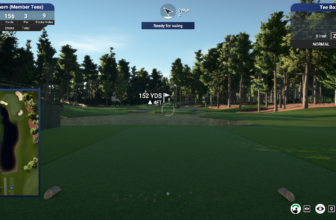
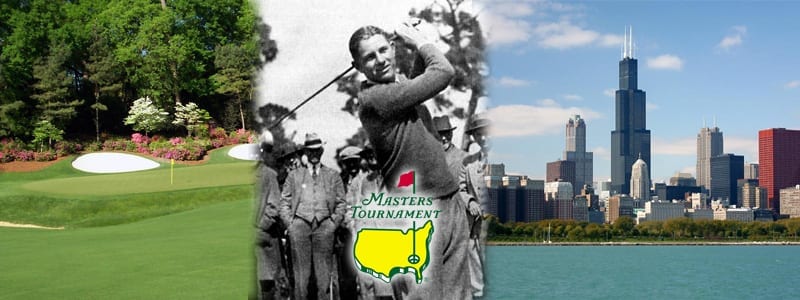

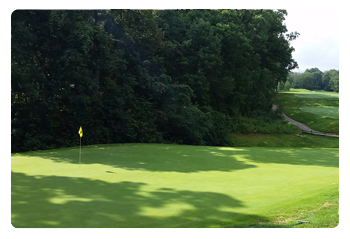 Find a Golf Course
Find a Golf Course Find a Driving Range
Find a Driving Range Find a Topgolf
Find a Topgolf Find a Golf Instructor
Find a Golf Instructor